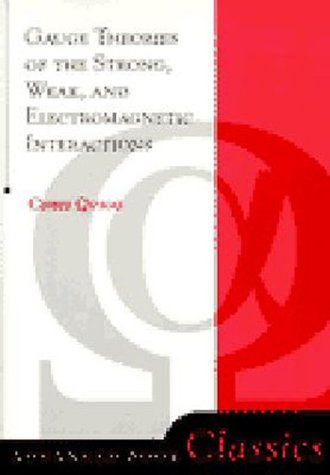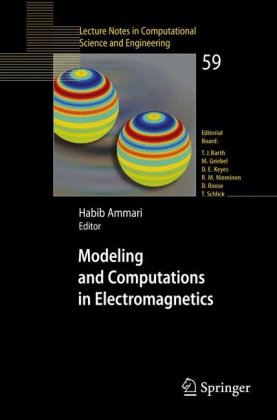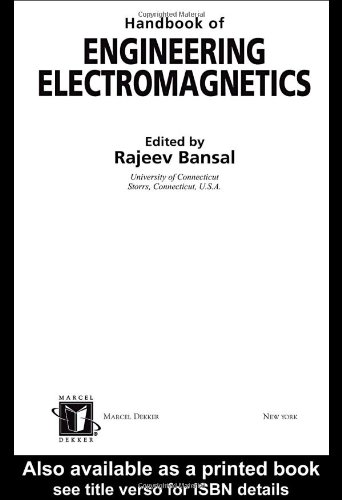Chris Quigg0201328321, 9780201328325, 9781429485104
Table of contents :
CONTENTS……Page 8
Editor’s Foreword……Page 6
Preface……Page 12
CHAPTER I: Introduction……Page 18
1.1 Leptons……Page 20
1.2 Why We Believe in Quarks……Page 21
1.3 The Fundamental Interactions……Page 33
Problems……Page 36
For Further Reading……Page 39
References……Page 40
CHAPTER 2: Lagrangian Formalism and Conservation Laws……Page 43
2.1 Hamilton’s Principle……Page 44
2.2 Free Field Theory Examples……Page 46
2.3 Symmetries and Conservation Laws……Page 48
Problems……Page 51
For Further Reading……Page 52
References……Page 53
3.1 Historical Preliminaries……Page 54
3.2 Gauge Invariance in Classical Electrodynamics……Page 56
3.3 Phase Invariance in Quantum Mechanics……Page 58
3.4 Significance of Potentials in Quantum Theory……Page 60
3.5 Phase Invariance in Field Theory……Page 62
3.6 Feynman Rules for Electromagnetism……Page 65
Problems……Page 67
For Further Reading……Page 69
References……Page 70
4.1 Motivation……Page 71
4.2 Construction……Page 72
4.3 Some Physical Consequences……Page 77
4.4 Assessment……Page 80
For Further Reading……Page 81
References……Page 82
CHAPTER 5: Hidden Symmetries……Page 83
5.1 The Idea of Spontaneously Broken Symmetries……Page 84
5.2 Spontaneous Breaking of Continuous Symmetries……Page 89
5.3 The Higgs Mechanism……Page 90
5.4 Spontaneous Breakdown of a Non-Abelian Symmetry……Page 93
5.5 Prospects……Page 95
Problems……Page 96
For Further Reading……Page 97
References……Page 99
CHAPTER 6: Electroweak Interactions of Leptons……Page 100
6.1 An Effective Lagrangian for the Weak Interactions……Page 101
6.2 Intermediate Vector Bosons……Page 114
6.3 The Standard Model……Page 123
6.4 Neutral-Current Interactions……Page 135
6.5 The Higgs Boson……Page 145
6.6 Renormalizability of the Theory……Page 152
Problems……Page 156
For Further Reading……Page 160
References……Page 162
CHAPTER 7: Electroweak Interactions of Quarks……Page 164
7.1 The Weinberg–Salam–Glashow–Iliopoulos–Maiani Model……Page 165
7.2 Electron–Positron Annihilations……Page 173
7.3 Deeply Inelastic Lepton–Hadron Scattering……Page 181
7.4 Hadron–Hadron Interactions……Page 201
7.5 Reflections……Page 205
Problems……Page 206
For Further Reading……Page 207
References……Page 209
CHAPTER 8: Strong Interactions among Quarks……Page 210
8.1 A Color Gauge Theory……Page 211
8.2 Charge Renormalization in Electrodynamics……Page 221
8.3 The Running Coupling Constant in QCD……Page 233
8.4 Perturbative QCD: An Example……Page 242
8.5 QCD Corrections to Deeply Inelastic Scattering……Page 246
8.6 Two-Photon Processes and the Photon Structure Function……Page 259
8.7 Strong-Interaction Symmetries……Page 267
8.8 Color Confinement……Page 271
Problems……Page 275
For Further Reading……Page 279
References……Page 284
CHAPTER 9: Unified Theories……Page 286
9.1 Why Unify?……Page 287
9.2 The SU(5) Model……Page 289
9.3 Nucleon Decay……Page 304
9.4 The Baryon Number of the Universe……Page 307
9.5 An Assessment……Page 310
Problems……Page 311
For Further Reading……Page 312
References……Page 314
Epilogue……Page 316
A.l Four-Vectors and Scalar Product……Page 318
A.2 Dirac Matrices……Page 319
A.4 Dirac Equation and Dirac Spinors……Page 321
References……Page 324
B.l Phase-Space Formulas: Decay Rates and Cross Sections……Page 325
B.2 Feynman Rules: Generalities……Page 326
B.3 Feynman Integrals……Page 328
B.4 Regularization Procedures……Page 330
B.5 Feynman Rules: Electrodynamics……Page 331
References……Page 332
References……Page 333
B……Page 334
E……Page 335
I……Page 336
M……Page 337
R……Page 338
U……Page 339
Z……Page 340
C……Page 342
E……Page 343
F……Page 344
H……Page 345
L……Page 346
N……Page 347
P……Page 348
S……Page 349
U……Page 350
Z……Page 351







Reviews
There are no reviews yet.